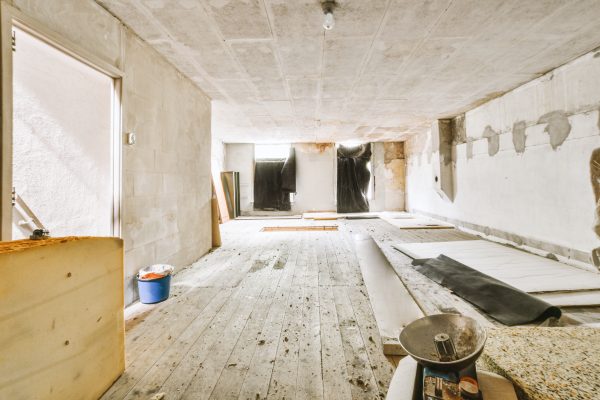When it comes to real estate investments, whether you’re a developer, property owner, or an architect advising clients, deciding between renovating an existing structure or starting new construction is a pivotal choice. On average, buying a pre-existing home costs around $120 per square foot, whereas building a new one can cost closer to $150 per square foot, according to Forbes. Each option presents unique advantages and challenges, but the ultimate aim is to maximize return on investment (ROI). In this blog, we dive into the key factors that impact ROI for both renovation and new construction projects, offering valuable insights to help you make the best decision for your next venture.
Understanding ROI in Real Estate Projects

ROI, or return on investment, is a metric used to evaluate the profitability of an investment. In the context of real estate, it measures the return relative to the cost of a project, factoring in not only direct expenses but also potential revenue gains, market trends, and long-term value. When comparing renovation to new construction, the decision often hinges on which option is best when maximizing ROI, considering both short-term and long-term benefits.
Key Factors for Maximizing ROI in Renovation and Construction Projects

Cost Considerations: Balancing Initial Investment with Long-Term Gains
One of the primary factors influencing ROI is the initial cost of the project. Renovation projects generally require a lower upfront investment compared to new construction. Renovating an existing structure often involves fewer material costs and less labor, making it an appealing choice for budget-conscious clients. However, the scope and complexity of the renovation can significantly affect the cost. Hidden issues such as structural damage, outdated electrical systems, or hazardous materials (like asbestos) can lead to unforeseen expenses, potentially diminishing the ROI.
On the other hand, new construction typically involves a higher initial outlay, including costs for land acquisition, design, materials, and labor. However, building from scratch allows for more control over design, quality, and sustainability, which can translate into higher value and lower maintenance costs over time. Modern materials and technologies used in new construction can also offer energy efficiency, further reducing operating costs and maximizing ROI in the long run.
Timeframe: Weighing Time to Market Against Potential Profits
Time is another crucial factor when evaluating ROI. Renovation projects generally have a shorter timeline than new construction, meaning the property can be ready for use or sale sooner. This faster turnaround can result in quicker revenue generation, which is particularly beneficial in a hot real estate market where demand is high.
However, renovation projects can also face delays due to unexpected challenges like discovering hidden damage or needing to comply with new building codes. New construction, while typically requiring a longer timeline, offers more predictability. With a well-planned schedule, new construction projects can avoid many of the surprises that often accompany renovations, allowing for better management of time and resources.
At BizForce, our skilled architects are adept at navigating the complexities of both renovation and new construction timelines. They work closely with clients to develop realistic, efficient schedules that anticipate potential challenges, whether it’s accelerating a renovation to capitalize on market demand or meticulously planning a new construction to ensure a smooth and predictable process. By leveraging their expertise, BizForce architects help clients make strategic decisions that optimize time management and maximize ROI.
Market Trends and Location: Tailoring Your Approach to Market Demands
Understanding market trends is vital in maximizing ROI. In some cases, a well-executed renovation may offer a higher return, especially in a desirable location with limited new construction opportunities. Historic or older properties in prime locations can be revitalized to retain their charm while offering modern amenities, appealing to buyers or tenants who value character and location over newness.
Conversely, new construction might be more advantageous in areas experiencing rapid growth or redevelopment. In such locations, there is often a strong demand for modern, energy-efficient buildings that offer advanced amenities. Here, the ROI can be maximized by capitalizing on the demand for new developments that cater to contemporary lifestyles.
Sustainability and Green Building: Weighing Environmental Impact and ROI

Sustainability has become a significant factor in determining the ROI of both renovation and new construction projects. Renovating an existing building can be inherently more sustainable by reducing the need for new materials and minimizing waste. Additionally, renovating to improve energy efficiency—such as upgrading insulation, windows, and HVAC systems—can enhance a property’s value and appeal to environmentally conscious buyers or tenants.
New construction, however, provides a unique opportunity to incorporate sustainable building practices from the ground up. This can include designing for energy efficiency, using sustainable materials, and integrating renewable energy sources like solar panels. Buildings designed with these features often have lower operating costs, reduced environmental impact, and increased appeal in a market that values sustainability, thereby maximizing ROI in the long run.
Functional and Aesthetic Flexibility: Meeting Modern Needs
Renovation projects often come with limitations in terms of design and functionality, especially if the existing structure has outdated layouts or lacks modern amenities. While renovations can enhance the aesthetics and functionality of a building, they may not always meet the standards of new construction, particularly when it comes to energy efficiency, structural integrity, and compliance with current building codes.
New construction offers complete freedom in design, allowing for the creation of spaces that are tailored to modern needs and preferences. This flexibility can be a significant advantage when targeting specific markets or clientele. For instance, open floor plans, smart home technology, and adaptable spaces are highly sought after and can significantly impact a property’s desirability and ROI.
Risk Management: Assessing the Variables
Risk is an inherent aspect of any real estate project, but the types and levels of risk differ between renovation and new construction. Renovations carry the risk of uncovering unexpected issues, such as structural damage or outdated infrastructure, which can lead to cost overruns and project delays. There is also the risk that a renovation might not add as much value as anticipated if the changes do not align with market preferences.
New construction, while generally more predictable in terms of budgeting and scheduling, carries its own set of risks, such as fluctuating material costs, regulatory changes, or delays due to weather or labor shortages. However, these risks can be mitigated with thorough planning, fixed-price contracts, and effective project management.
Conclusion: Choosing the Right Path for Maximizing ROI
Ultimately, the decision between renovation and new construction should be based on a thorough analysis of the specific project, location, market trends, budget, and long-term goals. Renovation may offer a quicker return and lower initial investment, making it ideal for properties with historical or sentimental value or those located in markets where new construction is limited.
New construction, however, allows for complete control over the design, functionality, and sustainability of the building, which can lead to higher long-term value and lower maintenance costs. It is particularly beneficial in markets with strong demand for modern, energy-efficient buildings.
Both renovation and new construction have the potential to maximize ROI, but the best choice will depend on the unique circumstances and objectives of each project. By carefully weighing the factors discussed above, you can make a more informed decision that aligns with your goals and maximizes your investment returns.
Make the Most Out of Your Next Project with BizForce
Ready to make the most out of your next project? Partner with BizForce, where our expert architects bring unparalleled knowledge and experience to every stage of your decision-making process. Whether you’re considering renovation or new construction, our team will help you analyze every detail—from market trends to design functionality—ensuring your project achieves the highest possible ROI. Don’t leave your investment to chance; let BizForce be your guide to a smarter, more profitable future in real estate.
Connect with us today and take the first step toward a successful partnership! Contact us here.
